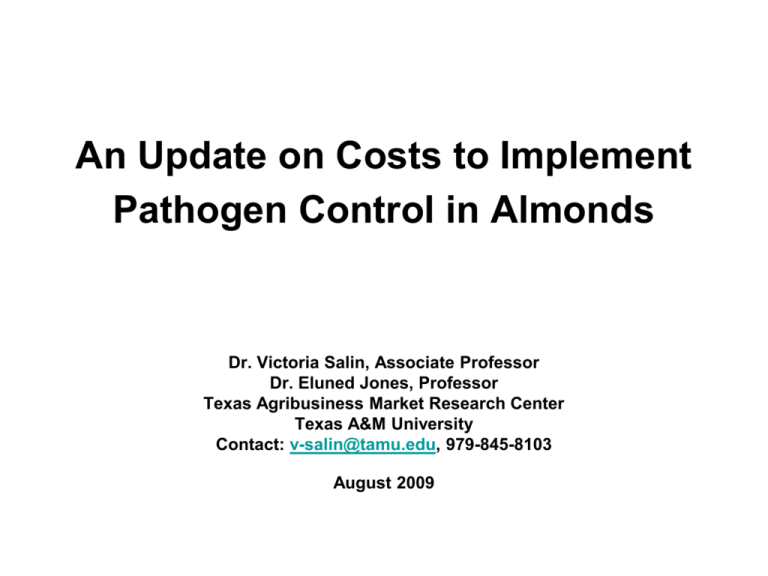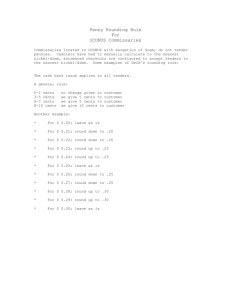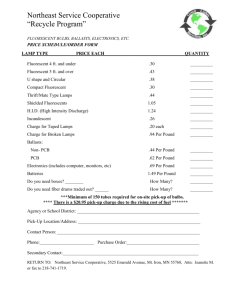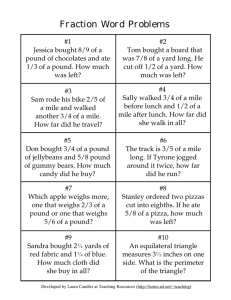An Update on Costs to Implement Pathogen Control in Almonds
advertisement

An Update on Costs to Implement Pathogen Control in Almonds Dr. Victoria Salin, Associate Professor Dr. Eluned Jones, Professor Texas Agribusiness Market Research Center Texas A&M University Contact: v-salin@tamu.edu, 979-845-8103 August 2009 Overview of the Presentation • Findings: – Operating costs – Capital investments – Market disruptions – Costs of oversight/assurance • Conclusions and implications – Market for treatment – Auditors’ credibility • Research methods 2006 • 810 million pounds would need treatment • Operating costs ~ $22-31 million, ignoring transportation 2009 • 502 million pounds shipped to North America • Operating costs $28 million - $34 million • Capital costs ~ ~ ~ $4 million -10 million • Validation of technology is more costly than anticipated. Terminology Operating costs Capital investments Machinery Variable expenses Routines, protocols, and systems for safer foods Labor Validation and testing Energy Audit - certification Raw materials Operating costs Table 1. Operating costs of the almond food safety Action Plan, by category All respondents (Unadjusted) Shipments (average per firm) Cost items Total Cost Custom treatment charges Packaging Transport Identify custom provider Handler treatment plan Audits by DFA ABC compliance reports USDA inspection DV program recordkeeping DV program plans 4,685,302 % treated in-house % treated custom % DV Source: Survey of almond handlers. Within group statistics – (Unadjusted) Small Medium Large 282,195 2,211,500 19,613,400 6.52 4.74 1.30 2.30 1.70 0.44 0.31 0.76 0.27 1.06 0.34 6.05 4.75 1.39 2.02 1.44 0.39 0.38 1.04 0.30 1.32 0.36 10.08 5.10 1.43 2.59 2.02 0.50 0.17 0.71 0.09 0.75 0.41 3.10 4.37 1.09 2.37 1.67 0.43 0.40 0.48 0.41 1.16 0.26 11.39 60.95 18.14 4.44 61.89 11.67 7.14 78.83 12.83 24.57 44.43 31.00 pounds Cents per pound Product Flows and Costs under Action Plan Custom treatment In-house treatment Direct verifiable Other Share of North Amer. shipments 61% Survey reported costs (cents per pound) Total cost ~ 6.76 cents/pound. 4.74 + 1.3 +2.3 +… 11% ****** 18% 1.06 +.34 10% Source: Survey of almond handlers. Market Price and Supply Situation 1,600,000 1,400,000 $1.55 1,200,000 $1.11 Increasing supply and falling price. $2.06 $1.57 $2.21 $2.81 $0.91 $0.86 Production $0.97 $1.56 800,000 Exports $1.41 600,000 $2.08 $2.48 400,000 Total cost ~ 6.5 cents per pound. Burden of Action Plan relative to market price ~ 4%. 200,000 0 19 95 /9 6 19 96 /9 7 19 97 /9 8 19 98 /9 9 19 99 /0 0 20 00 /0 1 20 01 /0 2 20 02 /0 3 20 03 /0 4 20 04 /0 5 20 05 /0 6 20 06 /0 7 20 07 /0 8 20 08 /0 9 1,000 pounds 1,000,000 Source: NASS. 2008/09 is forecast. $ values are farm price per pound. Capital Investments Survey reports are very limited and should be interpreted with caution. -Total $4-10 million. -Modifications to known processes are significant. -Some respondents excluded investments made prior to official rule. Table 2. Capital investments associated with the Action Plan, for new facilities and for modifications to existing equipment or facilities New Average of those reporting an investment $1,050,000 $193,000 $725,000 $150,000 Median (value greater than half of responses) Modification Technology validation has been costly • Process authorities $6,500 to $50,000. Access / delays were mentioned. • Laboratory costs have been high, particularly when repeated trials are needed. • Pathogen-reduction goals have conflicted with quality. Market Disruptions Sales Losses or Delays • Loss of sales to raw-organic consumer segment • Loss of sales to Canada due to PPO • Lost markets reported as major burden to smaller handlers • Timeliness of custom treatment Reports of Lost Markets due to Action Plan 14 number of respondents 12 10 8 6 4 2 0 No loss 5,000-50,000 50,001-500,000 500,000-5,000,000 Value of lost markets in $ Source: Survey of almond handlers. 2 unquantified responses on losses are not included here. Reasons for loss of markets Canada (PPO) n=2 Organic – raw n = 10 No loss of markets, n = 12 No. of respondents Timeliness of Custom Treatment 10 9 8 7 6 5 4 3 2 1 0 0 1 to 4 5 to 7 Days of delay in offsite treatm ent Source: Survey of almond handlers. 8+ Logistics Model Results • Treatment step in the marketing channel adds $28 million to the total cost • Capacity is adequate, with some constraints in the South • Diesel fuel is a relatively minor contributor to total cost ($2 more in fuel = $290,000) Costs of Oversight and Assurance Cost of Auditing • DFA audits the Handler Treatment Plans – Costs are low - $27,489 total – for 3 audits per year at each handler. – Recent adverse publicity on 3rd party audits, particularly the payment incentives. • Larger firms report higher auditing costs • Time, effort, hassle factor are difficult to quantify. Note: DFA = Amer. Council of Food Safety and Quality. Issues for Further Consideration • Competitiveness of the market for treatment services is a key issue in outlook for the program. • Acceptance of heat-treatment in the raworganic customer segment merits attention. • Credibility of third-party expertise supporting audit-verification functions is essential. Methods and Information Used in the Study Features of the Logistics Model • Linear programming – the gold standard for transportation modeling • Limitations of this model, mainly in the production features – Common treatment technology – Costs are the same everywhere – Result: the complex product flows are not recognized. – Much more data would be required to fix this. Issues not analyzed: Constraints on capacity at critical times throughout the year. Complexity of product types and access to acceptable treatment techology for that product. Information Sources Public secondary sources Industry Survey Almond Board records 24 responses Handler treatment plans Shipments data Energy Information Admin. Road atlas Survey and its Limitations • Field work is the best possible information – – – – Specific to the industry Original Up-to-date Drawbacks: Sensitive information, burdensome to respondents • There are a few problems in interpretation or and understanding of the questions • Major issue with non-response – Analysis and adjustments for potential non-response bias Weighting for Size Classes Table i. Cost estimates based on unadjusted survey responses compared with two weighting methods. Unadjusted Adjusted by Numbers Adjusted by of Respondents in Shipment Group Volumes in Group Total Cost (cents/pound) 6.52 6.76 4.24 Charge for Custom Treatment (cents/pound) 4.74 4.79 4.49









